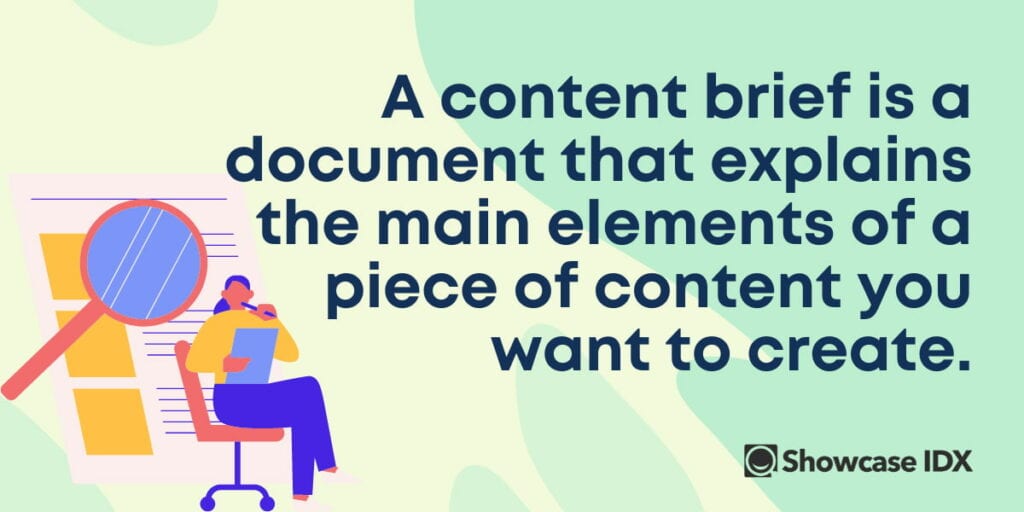The old saying goes that content is king on the internet, and that means creating good content is just as good for real estate SEO as it is for everything else. However, what are content briefs, and why do they matter for content production like making blog posts? Let’s take a closer look at why this matters for content teams.
What Is a Content Brief?

A content brief is a document that explains the main elements of a piece of content you want to create. Good briefs include considerations like the purpose of the content, its intended audience, formatting guidelines, primary topics to cover, and target keywords.
Many agents outsource their writing to external workers, so content briefs act as a valuable guide for a contracted writer or VA to create blog posts matching the tone and style you want on your site. Even if you’re not hiring externally, a brief will help a team member write a piece of content that’s worth putting on your blog.
Why Are Content Briefs Important in Real Estate SEO?

Content briefs have many benefits for real estate SEO. Among others, they can ensure alignment with your overall SEO strategy, improve your content’s quality, boost your presence on search engines, and provide consistency across your site.
The style guide sections are especially important because every writer has their own tone. Following a clear format for style ensures that you can maintain quality in your content, whether or not you’re contracting out to content creators.
Real estate is often highly competitive. Unless you have a captive market, chances are any client can find another agent in short order. High-quality SEO will make a good first impression and encourage people to trust you over competitive agents.
Also, your competitors will be doing SEO. If you can’t at least match them, then they’re going to get the majority of organic traffic from search engines. Many people look for real estate help online, and stellar contentmakes it easy to attract customers over time.
How To Create a Content Brief
A content brief will add a substantial value to ANY article you write for your website. If you have an more in-depth SEO plan, we’ll walk through that below. Just know that creating a content brief will help you even if you’re creating a one-off article.
Now on to the more in-depth walkthrough for what you need as you invest in content marketing that will actually improve your business.
First, start by identifying your audience. Content marketing works best when you have a specific audience, and detailed content briefs will represent this as part of a good content strategy. Think about the kinds of topics that attract search volume within that audience. For real estate, the audience is usually property buyers, other Realtors (for referral business), or industry support.
Next, pick a specific topic to discuss. You can use a keyword research tool to locate primary and secondary keywords to include, which aids content creators in crafting better work. Don’t overdo it, though, as stuffing in too many keywords reduces the quality of your content. Keywords are a spice, not a main ingredient.
From there, figure out the structure you want to use. Sometimes you may want to make list posts, while other times you may look at blogs or new content types. After deciding on the type of content you want, you can further the content creation process by defining the primary points and any subheadings you want to address.
For example, in this guide, “how to create a content brief” is a heading because it’s highly relevant to the main topic.
After that, you can add any extra references or examples to help your content writer understand what you’re looking for.
Don’t be too exact in writing your outline. If you try to micromanage every paragraph, you may as well write it yourself. Instead, once you have the basic formatting, have a writer you trust take care of the other details.
What Is Frase? And How It Makes Briefs Easy?

Frase is an online content generation platform. It has four major sections that make it easier to create higher-quality content. These sections include briefing, writing, optimizing, and analyzing, each of which has its purpose as part of an all-in-one service. In particular, you can use Frase to find secondary keywords, generate blog templates, and aid your content plan management.
We used Frase to help create the content you’re reading right now, and the fact that you’re here shows how well it works.
How To Use Frase for Content Briefs and Blog Post Templates
Frase is an excellent tool if you have an experienced writer who can make the most of it, but even casual content marketers can see many benefits when planning out their content.
Start by using Frase’s Content Brief system to build an outline and decide what content will make the most sense. Remember, don’t simply rely on its advice, but compare the output to what you know about your target audience and their likely search intent.
As part of this, Frase’s SEO tools can play a positive role in making creative briefs, suggest a targeted word count, and provide information on different types of blog posts that you can create. It’s not a good place for graphics, so don’t expect to make an infographic post, but you can expect it to work well for most written content.
After you figure out your content outlines, you can either start writing the content yourself or ask a writer to step in and handle this part for you. A good writer can produce content of practically any length, not just the average word count of your competitors, and integrate the material into your existing content marketing strategy.
Frase has a range of tools for creating content, too, such as suggested text if a writer gets too stuck on something.
Optimizing goes hand-in-hand with writing content, as you can often do both simultaneously.
As part of your search engine optimization efforts, writers can add long-tail keywords, provide external links, make sure your primary keyword shows up often enough, and even add internal links to guide users through your sales funnel.
After you post the content, you can use Frase’s analytics systems to examine your content’s performance and look for ways to improve it. I prefer using this over SuferSEO and similar tools.
That is the secret trick that many of your competitors forget about or overlook. Content creation isn’t a one-and-done process where all you do is create blog posts as part of a basic content strategy. Instead, seeing what works and refining future content based on that data is how you move toward the content that works best.
For instance, you may find that list posts perform significantly better than traditional articles. If that’s the case, you could update your blog post template to focus on lists and make sure every primary keyword you add emphasizes what people who read lists are searching for. Similarly, your external links should support what’s on the list.
Key Takeaways
Content briefs are the foundational element of creating real estate SEO content. They detail who you’re trying to reach, what material matters to your audience, and what a writer should do to try and reach that audience. A great writer can create excellent real estate content even if they don’t know anything about it when they begin just by following the information in a good brief.

Frase is a great place to begin creating content briefs, and you can direct the writer to create content within it for optimization.
Don’t rely too heavily on its automated components, as those may not be able to access information like specific statistics or your personal industry experience that you may want to include. However, the keyword suggestions are usually good as long as you don’t try to use every single one of them.
One of Frase’s better features is that it shows you an analysis of how competing content performs. If someone else’s content scores just 25%, you can aim for 30% or 40% and still do better than your competitors. 100% is the best of all but acts as a suggested place for stopping if it seems adding more keywords would make the content worse.
Try using Frase for creating brief today and get a feel for how it works. They also have a service that will create a full content brief for you if you simply provide them a keyword and article topics. That’s worth a try as well.
FAQs
Here are some common questions people have about content briefs and how they relate to SEO.
What is the purpose of content briefs?
The primary purpose of content briefs is to create a clear outline for making your content. A brief is essentially a step-by-step guide that addresses every important question, from what kind of search query your audience is making to the tone of voice you want to use. Content briefs also ensure your content is consistent enough to feel familiar to anyone who reads a lot of it.
As a comparison, think of a content brief being similar to a template you might use when creating brochures for a house. A template should define where to put pictures, where to advertise the price, what to discuss, and what elements of a listing to prioritize. Rather than relying on you to remember the details every time, a good template acts as a guide to ensure you don’t forget anything important.
How do you write a content brief example?
The best way to write a content brief is to first figure out the basic information, like your website’s formatting. Many websites use an 11-pt Arial font, without excessive formatting like bolding or italics that could distract the reader. (See how it works there?)
A good content brief will also include foundational elements like the tone of voice and overall style of writing you want to use.
If I’m writing in first-person, it sounds very intimate because I know what I’m talking about, and I’m ready to convey that to the reader. I like writing in the first person because it’s an excellent way to build trust, especially when I’m making content that’s supposed to be coming from me and encouraging people to trust me.
You may find that second-person content is better. It focuses on you, the reader, and many people enjoy that because they prefer being the center of attention. If they aren’t looking to get your expertise, this is often the best tone. Second-person content is sometimes slightly opinionated but not as much as first-person material.
For academic-type material, the reader might benefit more from third-person content. Third-person writing is factual and an excellent way to discuss market information without injecting personality. When the reader’s done, they may move on to another part of your site and start looking for the personal information of the other two tones.
Do you see how each of those works? Content should usually stick with a single style and point of view throughout, but I used all three primary tones to showcase their differences. The reason I’m explaining it this way is that once you understand the options, it’s easier to pick between them when making your content briefs.
What is an SEO content brief?
An SEO content brief is a brief that focuses specifically on search engine optimization. Not all content is SEO, though much of what you put on the internet is. For example, a house description isn’t usually optimized, as that’s not something people search for online.
An effective SEO content brief will include the keywords you want to have in your article and all of the headers for your content. If you want to go a step further, tell your content writer how much they should edit it if they think they can improve the material. For example, a header may be in your table of content, but a writer might decide it makes more sense to combine that information with another section.
What are the benefits of a content brief?
The benefits of content briefs vary but include consistency in your content and the ability to have any qualified writer produce content for you. Content briefs also serve as a foundation for understanding the content you make and checking the final writing to be sure it matches what you were going for.
What is a content brief template?
A content brief template is a fill-in-the-blank document that has your universal information, like formatting, already in it, then additional sections for content-specific information and directions. Many real estate companies have a style guide, then create headings and keywords for each piece of content.
Having a template means you don’t have to spend time recreating your basic information every time you’re making content.





